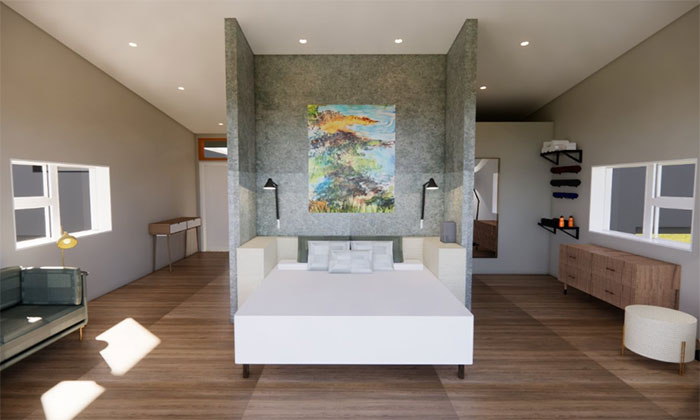Aiming to highlight the transformative potential of virtual reality in housing design for aging populations, Marymount University made a significant impact at HUD’s 2024 Innovative Housing Showcase.
Held on the National Mall from June 7-9, this event – in its fourth year – raises awareness about innovative and affordable housing designs and technologies that can increase housing supply, lower construction costs, improve energy efficiency and resilience and reduce housing expenses for owners and renters. With an estimated 5,000 visitors, the showcase attracted policymakers, homebuilders, innovators, entrepreneurs, media and the general public.

Marymount stood out among the 43 exhibitors as one of only a few participating higher education institutions. Its exhibit – ‘Enhancing Age-Friendly Housing through VR: A Showcase of Innovative Design Solutions’ – was a collaborative effort between its Interior Architecture and Design program, its Engineering program and local community partner All Eco Design Center from Wheaton, Md. Visitors were invited to embark on an immersive journey through accessory dwelling unit (ADU) designs using virtual reality, created to empower aging consumers to identify challenges in home interiors with the assistance of architectural designs, renderings and more.
“We aimed to spark conversation around healthy materials for aging,” said Moira Denson, Associate Professor of Interior Architecture and Design at Marymount University. “Ultimately, we want the public to explore solutions from our designs that they can implement with designers. I wanted to bring our team together to ensure we are advocating for older adults while educating future designers, and also keep sustainable design materials front and center.”

The exhibit allowed visitors to experience spatial layouts, sustainable material selections and technological integrations optimal for ‘aging in place.’ A detailed Revit model demonstrated the intricacies of design solutions, while an analysis tool available via QR code enabled visitors to evaluate housing designs for age-friendliness based on research parameters.
“VR technology is becoming increasingly more accessible and important for designers. It allows us to immerse ourselves in our creations to view design and assess choices that can be changed on the fly,” said Dr. Eric Bubar, Professor of Engineering at Marymount University. “With this software, we can easily change materials, adjust colors and textures, perform complex physics simulations of structural strength and explore the impacts of these characteristics before building a design.”
The Marymount team included summer research fellows like Olivia Kearney, a rising senior who helped set up design renderings and conducted assessments at the showcase.
“One of the insights I’ve taken away from this year’s housing showcase was the diversity in roles and occupations of people in attendance,” Kearney shared. “This led to many varying conversations about the project, challenging me to think from different perspectives – architects, engineers, construction workers and different family roles.”
Kaitlyn Doyle, a 2024 master’s degree recipient, also contributed significantly to the project. At last year’s showcase, she conducted initial housing assessments with Denson and returned this year to assist with the experience.

“The research we are doing affects everyone at some point in their lives. As I get older and see my parents, grandparents and other loved ones age, I just want to help them and make their lives better,” Doyle said. “As designers, we are taught to think about the longevity of everything in our decisions. This experience has made me realize how important that is and how early decisions can impact a lifetime. I believe this experience has given me great empathy as I embark on my design career.”
The research featured in Marymount’s exhibit was previously shared on the local cable TV show ‘Aging Matters.’ Watch for more insights into how this work fosters age-friendly design solutions while contributing to reduced health care costs, enhanced quality of life and increased community resilience.





